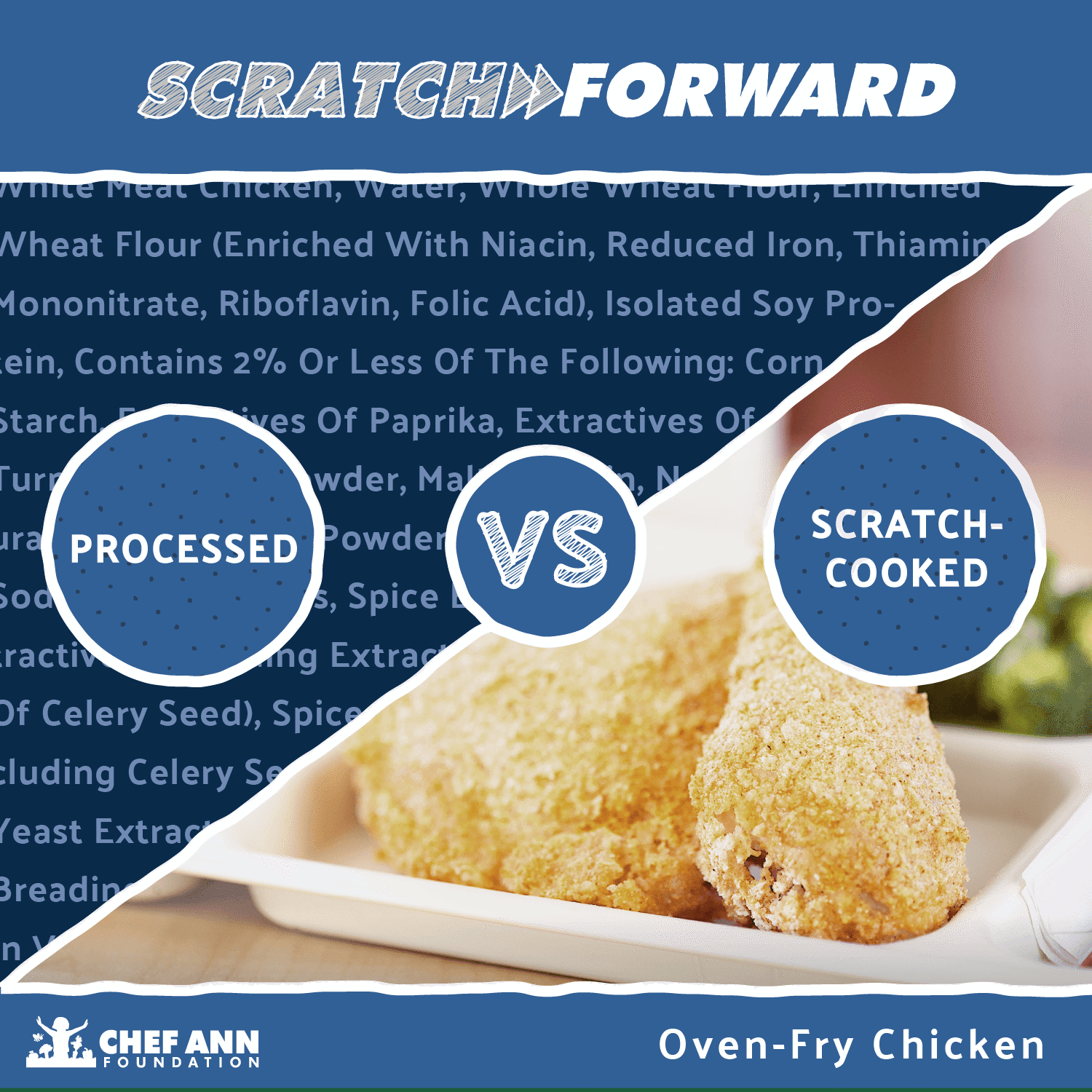
Here at the Chef Ann Foundation, we’re dedicated to promoting whole-ingredient, scratch cooking in schools. Please consider supporting our work to ensure all children have equal access to fresh, healthy, delicious food providing them the foundation to thrive and meet their true potential.
As we enter National School Lunch Week, the importance of fresh, healthy, scratch-cooked school meals is top of mind for many parents and folks in the school food world—and on Capitol Hill. After more than 50 years, the Biden-Harris administration announced the second-ever White House Conference on Hunger, Nutrition, and Health. For the first time since 1969, the White House announced its commitment to improving food access and affordability; prioritizing nutrition, food security, and health care access; supporting physical activity; and amplifying nutrition and food security research.
President Biden addressed school food and announced that his administration intends to provide free school meals for all, helping to make scratch cooking and local procurement possible across school districts nationwide. And although the COVID-19 pandemic still presents various challenges in the realm of school food, now is the time to bring “scratch forward” to the menu—with simple ingredients to fuel young bodies and minds. By taking incremental steps towards scratch cooking, school food programs can further support our nation’s kids and positively impact the planet.
A Brief History of School Lunch
Many of us remember going through the school lunch line to find food that was less than appetizing and hardly nutritious. When the National School Lunch Act was passed in 1946, early school meals largely consisted of batch cooking with commodity staples such as poultry, beef and dairy products. Although far from “healthy,” school menus weren’t yet full of questionable ingredients or as highly-processed as they became. So what changed?
We’ll keep it brief. Around the same time that the National School Lunch Act was passed, one of the major nutritional milestones in human history took place: the chemical revolution. It was during World War II that new processing techniques were developed to make lighter, longer-lasting food for the military, later encouraging food companies to explore modern non-perishable goods such as granola bars, crackers and juice pouches. The result was cheap food that’s abundant, highly-processed, nonperishable and—unfortunately—covered in chemical fertilizers, herbicides, and pesticides. Even more unfortunate is that these foods went beyond the military, and highly-processed food became the norm across many other demographics, including school lunches. In general, it’s considered easier for someone to cut open a box of frozen chicken nuggets than it is to hire a chef who can prepare a flavorful, oven-baked chicken breast.


We’ll keep it brief. Around the same time that the National School Lunch Act was passed, one of the major nutritional milestones in human history took place: the chemical revolution. It was during World War II that new processing techniques were developed to make lighter, longer-lasting food for the military, later encouraging food companies to explore modern non-perishable goods such as granola bars, crackers and juice pouches. The result was cheap food that’s abundant, highly-processed, nonperishable and—unfortunately—covered in chemical fertilizers, herbicides, and pesticides. Even more unfortunate is that these foods went beyond the military, and highly-processed food became the norm across many other demographics, including school lunches. In general, it’s considered easier for someone to cut open a box of frozen chicken nuggets than it is to hire a chef who can prepare a flavorful, oven-baked chicken breast.
Fast forward to 2010, when Congress passed the Healthy, Hunger-Free Kids Act (HHFKA). There’s now a plethora of research that demonstrates how unhealthy food leads to unhealthy kids and health issues such as type 2 diabetes. The HHFKA became the first attempt to safeguard our children’s health since the Child Nutrition Act of 1966, whose declaration of purpose includes this statement:
“In recognition of the demonstrated relationship between food and good nutrition and the capacity of children to develop and learn, based on the years of cumulative successful experience under the national school lunch program with its significant contributions in the field of applied nutrition research, it is hereby declared to be the policy of Congress that these efforts shall be extended, expanded, and strengthened under the authority of the Secretary of Agriculture as a measure to safeguard the health and well-being of the Nation’s children, and to encourage the domestic consumption of agricultural and other foods, by assisting States, through grants-in-aid and other means, to meet more effectively the nutritional needs of our children.”
Ingredients of Concern
The intent to serve healthier food to our nation’s children was certainly there, and in the years since, organizations like the Chef Ann Foundation have worked tirelessly to continue making this a reality. As mentioned above, school lunches became highly processed and full of concerning ingredients. But it doesn’t stop with herbicides and pesticides; there’s now a much larger list of “ingredients of concern,” which covers popular ingredients in processed foods like artificial flavors and sweeteners, carrageenan, monosodium glutamate (MSG), high fructose corn syrup, nitrates/nitrites, and sulfates/sulfites, to name a few.
Ingredients with complicated names that are highly-processed are unhealthy for many reasons, and this 2021 Ingredient Guide outlines these ingredients and their causes for concern. Notably, most food additives have not been tested for safety according to the Food and Drug Administration’s testing recommendations, and there is no policy for using additional safety factors to better protect children.
That being said, there are still many school lunch items that include dozens of ingredients and often those that are most concerning. For example, typical processed chicken nuggets contain 34 ingredients, including highly processed maltodextrin, silicon dioxide, and sodium phosphates. In comparison, oven-roasted chicken contains eight total ingredients, four of which are spices: chicken, buttermilk, salt, pepper, flour, cornmeal, chili powder, and paprika.

Connecting Better Ingredients to Equity
The National School Lunch Program reaches a whopping 31 million children every day. That’s an enormous opportunity to fuel those children with food that will greatly improve their cognitive abilities and potential to thrive. Real food with fewer, simpler ingredients can increase fiber intake and lead to longer attention spans, improved mental health, and even better test scores. In 2020, over three-quarters of all school lunches were served to students who qualified for free or reduced price lunch. These are students who depend heavily on school meals to fuel them throughout their day—children whose life circumstances might not allow them to be fed high quality, nutritious food at home due to social and economic constraints and injustices.

Connecting Better Ingredients to Equity
The National School Lunch Program reaches a whopping 31 million children every day. That’s an enormous opportunity to fuel those children with food that will greatly improve their cognitive abilities and potential to thrive. Real food with fewer, simpler ingredients can increase fiber intake and lead to longer attention spans, improved mental health, and even better test scores. In 2020, over three-quarters of all school lunches were served to students who qualified for free or reduced price lunch. These are students who depend heavily on school meals to fuel them throughout their day—children whose life circumstances might not allow them to be fed high quality, nutritious food at home due to social and economic constraints and injustices.
School lunch is not only an issue of nutrition; it’s an equity issue. Making school meals healthier across the board allows students from different socioeconomic backgrounds to thrive just as much as their privileged counterparts—and a key factor in healthy school food is cooking from scratch.
Not only does scratch cooking allow districts more control over their ingredients and menu items, it gives them the flexibility to run a more environmentally friendly and sustainable meal program. Districts can alter their procurement practices to purchase locally grown produce or alter preparation techniques to reduce food waste. In addition to lowering school food’s impact on the environment, sustainable lunchrooms offer a variety of learning opportunities for students.
The Bottom Line
Bringing “Scratch Forward” to school districts means bringing healthier, cooked-from-scratch school food to the forefront of the National School Lunch Program—but we understand big changes don’t happen overnight. Taking consistent, small steps towards scratch cooking is instrumental in the fight for school food reform. By swapping menu items like chicken nuggets and processed mac and cheese for more wholesome alternatives, like oven-baked chicken thighs and scratch-cooked mac and cheese, we can give students across the country access to food that is beneficial to their growing bodies and minds, and simultaneously benefit the environment. Keeping it simpler with fewer ingredients ensures that children are not ingesting harmful chemical ingredients that have potentially negative effects on their long-term health. Instead, we are creating an opportunity to instill lifelong healthy eating habits and contribute to the nutritional wellbeing of all our nation’s kids.
Help us continue the fight for school food reform by supporting our work today.







